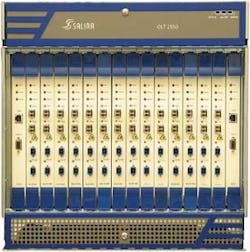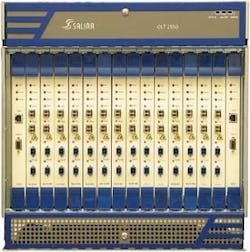CableLabs preps EPON for MSO business services support
By Stephen Hardy
Cable multiple systems operators (MSOs) face a dilemma when it comes to deciding the best network approach for business services. They can use their existing DOCSIS-based hybrid fiber/coax networks and place a cable modem at the customer premises, or they can create a separate network, perhaps using Carrier Ethernet platforms and WDM systems. The DOCSIS approach uses familiar technology and back office operational processes, but is probably not as well suited to the task as the optical Ethernet approach–which would suffer the overall operational inefficiencies inherent in running multiple networks within the same footprint.
To the rescue comes cable industry specifications organization CableLabs (fronting initially for a trio of MSOs and their vendor partners), which expects to release the first set of guidelines for DOCSIS Provisioning of EPON (DPoE) in February. The new specs aim to improve the business services support features of both DOCSIS and EPON to create an infrastructure approach that would prove more economical than optical Ethernet.
DPoE could give EPON a larger role in MSO networks. Source: Hitachi-CTA
Like any new specification, DPoE faces the usual questions regarding how well it will meet the requirements of its target audience. However, like any implementation of optical access technology in MSO networks, it also faces the question of whether it will prove to be more than just a niche technology.
Opening gambit
DOCSIS-enabled EPON systems have been available for several years. While DOCSIS-friendly GPON hardware has seen use, cable companies in general appear to favor the IEEE-based EPON over the GPON technology whose specifications the MSOs' telco competitors helped to create.
While MSOs haven't deploy-ed EPON widely, particularly for residential applications, the technology has remained on their radar screens as a potential vehicle for business services. According to Curtis Knittle, the director of digital video services at CableLabs who has become involved in the DPoE specification effort, "Several of the MSOs that were using EPON equipment had a strong desire for multivendor interoperability. And they also had a strong desire for provisioning and scaling."
In particular, Comcast, Time Warner Cable, and Bright House Networks joined to push for a set of specifications that would enable DOCSIS-enabled EPON technology from multiple vendors to support business services in a manner comparable to optical Ethernet. Vendors from the systems (Hitachi Communications Technologies America and ZTE Corp.), chip (Broadcom via its Teknovus acquisition), and transceiver (Finisar, through its new Broadway Networks assets) worlds joined the effort to create the initial set of specifications.
These specifications, which will primarily be implemented as middleware, will focus on two primary goals:
Ensuring that compliant EPON systems support DOCSIS operations, administration, maintenance, and provisioning (OAM&P); management; security (a somewhat open-ended aspect within the IEEE EPON specs); data collection; and similar functions. Properly implemented, this aspect of the specification would promote interoperability among the optical line terminals (called "DPoE Systems" in the specification) and customer premises optical network units (which the specification calls "DPoE ONUs") from different suppliers.
Enabling service provision based on the Metro Ethernet Forum (MEF) model. The first version of the specification will support provisioning of Ethernet Private Line services. While Knittle didn't want to discuss specifics of what future versions of DPoE would include, support of additional MEF-supported services would be a good bet. "I think it safe to say that the operators that are involved with DPoE are embracing the MEF services," Knittle allows.
Knittle says that CableLabs played a somewhat passive role in the first version of DPoE, but will take a more active part in creation of the next version of the specifications, which he predicted will see release this November.
If a spec falls in the forest…
CableLabs issued a press release last fall trumpeting the impending DPoE specification release that carried quotes of support from the three sponsoring MSOs.
"We've embraced DOCSIS and EPON technologies and are focused on delivering IP and MEF-based services for business and commercial applications," read the most emphatic quote, from Craig Cowden, corporate vice president of network engineering and operations at Bright House Networks. "The DPoE specifications give us the ability to support multiple products and services based on those foundations."
However, quotes are one thing and actual deployments are another. None of the three MSOs accepted Lightwave's invitation to discuss their deployment plans. However, Mannix O'Connor, director of Hitachi Communications Technologies America (the company that has supplied Bright House with its EPON equipment) says he's not expecting an avalanche of DPoE deployments this year. "There will be installations in 2011. There absolutely will," he says. "But those will be more of the trial/showcase variety."
The rather sparse deployment of EPON technology represents one barrier to DPoE adoption in the near term. "Bright House Networks has a fairly large EPON network that Hitachi has worked with them for a few years to build. They run business services, residential, and cell tower backhaul on it," O'Connor explains. "But they're probably the exception. Time Warner and Comcast haven't really done much of this; they're doing Metro Ethernet."
O'Connor's statement illustrates one of the main questions proponents must answer before DPoE will see wide-scale acceptance: Why is it better than optical Ethernet–particularly if an MSO has already deployed optical Ethernet technology? Proponents would answer that EPON architectures generally require less fiber, particularly when compared with extended point-to-point optical Ethernet infrastructures. One would also expect opex savings to accrue from being able to leverage the same back office resources that currently support a cable company's residential offerings.
However, such opex savings are difficult to quantify without actual deployment data. Meanwhile, proponents must battle the perception among at least some MSO staffers that DOCSIS works well for residential uses but falls short of meeting business services requirements.
"Why would I use DOCSIS? It doesn't have the bandwidth. It's for residential; it doesn't do VLANs; I can't create multiple customers on one port–one cable modem is one customer and one service and that's it. I need more than that," O'Connor says, putting himself in the shoes of DPoE skeptics. "There are a lot of things they could say off the top of their heads about why it won't work. But a lot of those issues are being addressed by DPoE, if not in the first version that comes out, [then in] subsequent versions."
Meanwhile, CableLabs has set about the task of raising DPoE's visibility. The organization has scheduled an interoperability demonstration to enable supporters to show off their capabilities. However, in an act that's either just confidence or plain hubris, CableLabs scheduled the event for January 24–before the DPoE specifications will be publicly available. (Knittle says a draft version of the specs is available to vendors who sign non-disclosure agreements.)
A list of companies participating in the interoperability demonstration was not available as this issue went to press. However, the vendors behind the specification would appear to be natural participants. Equipment developers who have announced DOCSIS PON products, such as Arris Networks, Cisco, and Communications Test Design Inc. (through its acquisition of Alloptic), would be candidates as well–as would EPON chip houses. Other systems houses who have expressed interest in DPoE include Motorola and MRV Communications.
The interoperability event and specifications that CableLabs will unveil publicly in February would seem the first steps in a journey toward a business infrastructure option rather than that journey's end. Whether MSOs will want to participate in that journey will depend on how aggressively they have targeted business services provision in the near term–and how quickly DPoE will evolve to match the capabilities of cable companies' other options.
Stephen Hardy is editorial director and associate publisher of Lightwave

